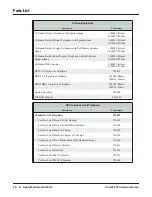
8
UK
Note:
If there are no numbers in the redial list, the display shows “EMPTY ”.
Using the corded base:
7.10
Making a call
t
Pick up the corded handset or press on the corded base.
t
Enter the phone number.
Warning:
There will be a 3-second delay, after picking up the corded handset or pressing the SPEAKER button,
before any digits will dial out, but any digit keys pressed during this time will still be detected and the
numbers will be dialled out after the delay period.
7.11
Making a Call From Direct Memory Keys
t
In idle mode, press M1, M2 or M3 to dial the number stored in the direct memory keys via speakerphone.
Lift up the corded handset to switch the call to the handset mode.
Note:
If the selected direct memory key is empty, an error tone is emitted via speakerphone and the corded base
will return to idle mode.
7.12
Answering a Call
t
Pick up the corded handset or press to answer the incoming call.
7.13
Ending a Call
t
During a call, put the corded handset on the base.
OR
t
If you are using the speakerphone, press to end the call.
7.14
Redial the Last Number
t
In idle mode, press
on the corded base. If there is a redial number, the number will dial out in
speakerphone mode.
Lift up the corded handset to switch the call to the handset mode.
7.15
Direct Memory Keys
There are 3 direct memory keys (M1 to M3) on the corded base for you to store frequent numbers, of up
to 24 digits each.
If more that 24 digits are entered, only the first 24 digits are stored.
7.15.1
Saving a Number in a Direct Memory Key
t
In idle mode, press
.
t
Enter the phone number.
t
Press M1, M2 or M3 to store the number in that memory.
If there is already a number in your selected direct memory key, the new number will replace the previous
number.
Note:
The Direct Memory Key cannot be cleared completely.
To remove a number, you can only overwrite it with a new number.










































